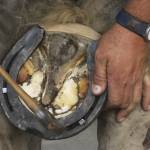Ouch! Foot-Sore Horses

Most horse owners have heard the phrase “tender-footed,” meaning foot soreness, and the same number have probably dealt with the problem in one way or another, but what causes the problem and what can you do to avoid it?
“Foot soreness is characterized by sensitivity when pressure is applied to the foot,” said Laura Petroski-Rose, B.V.M.S., a veterinarian with Kentucky Equine Research. “Horses with foot soreness can appear more painful when walking on hard surfaces, like asphalt or packed clay, than when walking on more forgiving terrain, such as grass or arena footing.
Foot soreness differs from an abscess, which is a compromise in the hoof structure due to bacterial infiltration. “With an abscess, as with any infection, the body builds an immune response to the bacteria, resulting in the formation of pus. Because the pus cannot escape, pressure from this fluid-filled space causes pain and results in lameness. With foot soreness, there is no bacterial component,” Petroski-Rose explained.
The causes of soreness can be divided into three broad categories: environmental, farriery, and genetics.
Environment. Weather-related changes, especially periods of rain followed by periods of drought or vice versa, frequently bring about foot problems in horses. Wet-dry cycles not only affect the texture of the ground but can also make hooves too brittle or soft and easily damaged. Owners should try to keep feet as dry and clean as possible during these weather changes.
Additionally, insect populations swell in warm weather, becoming bothersome to horses. Continuous stomping to shoo away insects can be traumatic to hooves and can cause internal damage, not to mention increased wear and incidence of hoof cracks.
Uneven ground and changing work surfaces are also risk factors for injury to hooves and other structures. Lastly, continuous concussive forces from jumping or other types of exercise can lead to trauma-induced injuries.
Farriery. Improper trimming and shoeing can be the source of foot pain. Shoes are used to compensate for conformational issues, to protect the hoof from wear and tear, and to enhance soundness and performance, but only experienced, conscientious farriers should be employed. Farriers should identify a propensity for thin soles so that pads can be used to provide sole support and protection from environmental factors or trauma.
“While poor farrier work could contribute to lameness, lack of appropriate hoof care is also a cause of lameness,” noted Petroski-Rose. Conformational issues, such as an unbalanced hoof, may develop from lack of proper or timely trimming and might lead to unsoundness. A long toe can result in a low heel, which predisposes that heel and toe, and other soft tissue structures, to damage, she said.
Genetics. Some horses are naturally born with poor conformation and may be predisposed to developing certain issues like soft or thin soles. Horses with flat feet tend to damage their soles more readily as the soles have more contact with ground surface. Horses with long pasterns tend to develop long toes and low heels, which can make a farrier’s job to correct that problem all the more difficult.
Finding relief for a sore-footed horse may require short- and long-term management changes.
Short-term assistance might include appropriate shoeing for terrain or conformation challenges and stalling when the weather is too hot or too wet or when the insect population seems to be especially irksome. Some horses are more tolerant of insects than others, so strategies to minimize exposure (face masks, fly sheets, fans, repellant, etc.) may be different for each horse.
Long-term solutions revolve around preventing the onset of foot soreness, namely regular, meticulous hoof care. Owners should find a farrier they have respect for and rapport with and who works in combination with a veterinarian to produce a well-balanced foot. Routine farrier visits are important to catch any abnormalities or potential problems before damage or trauma occurs. Many horses handle a typical five- to six-week shoeing or trimming interval well, but others might need fewer weeks between appointments. Horses should not be foot sore after a routine trim.
“Any new horse should be fully vetted, i.e., undergo a pre-purchase examination with radiographs, which will provide the horse’s health-care team with a baseline for comparison as ownership changes and consequent radiographs are taken throughout its life,” said Petroski-Rose. “This kind of historical data can be important if a lameness crops up in the future.”
Finally, nutrition is important. Horses should consume a well-balanced diet, which focuses not only on energy but also fulfills the daily requirements for protein, vitamins, and minerals. For many horses with poor-quality hooves, biotin supplementation provides the nutritional support necessary to support hoof growth, including the development of a strong hoof wall.
Research focusing on biotin supplementation has revealed that 20 mg of biotin daily produces optimal results for horses that respond to it. Giving more than 20 mg per day has yielded no additional benefits. Bio-Bloom PS (Bio-Bloom in Australia) provides 20 mg of biotin per day as well as several other nutrients required for optimal health of hooves and hair, including methionine, zinc, and iodine.
Are you unsure if you’re giving your horse a hoof-friendly diet? Ask a nutrition expert at Kentucky Equine Research today!








